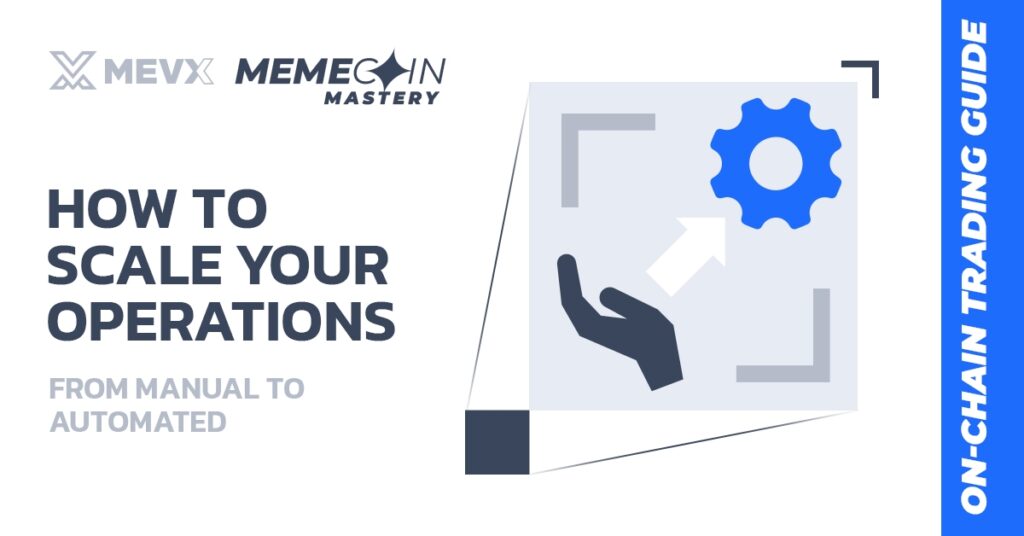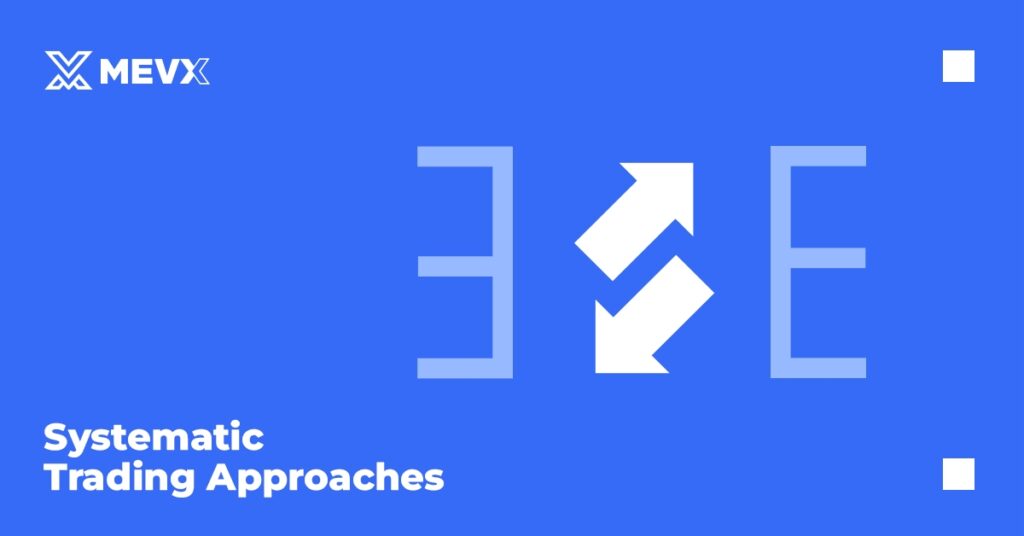The transition from manual meme coin trading to systematic automation represents a critical evolution for serious traders seeking consistent profitability and operational efficiency. This article will show you how to scale your operations.

How to Scale Your Operations
While human judgment remains essential for strategy development and market interpretation, automating routine tasks enables focus on high-value decision-making while reducing emotional trading errors and execution delays. How to scale your operations requires a careful balance between systematic efficiency and strategic flexibility.
Trade Execution Automation
Begin automation with clearly defined execution scenarios that don’t require complex market interpretation. Automated entry systems work best for objective criteria like new token launches meeting specific on-chain parameters, or exit triggers based on predetermined risk thresholds.
Implement systematic approaches for common trading scenarios: automatic position sizing based on liquidity analysis, staged exits triggered by on-chain signals, and rebalancing protocols that maintain target portfolio allocations. These automated processes ensure consistent execution of proven strategies while eliminating emotional override decisions that often lead to suboptimal outcomes in how to scale your operations.
Screening and Discovery Automation
Automated token screening represents one of the highest-value automation opportunities in meme coin trading. Scale your operations systems that continuously monitor new token launches across multiple chains, filtering candidates based on your established criteria for liquidity, holder distribution, and fundamental characteristics.
Advanced screening systems integrate multiple on-chain data sources to eliminate false positives and highlight opportunities that match your successful trading patterns. Include social media monitoring, developer wallet analysis, and cross-reference checks against known scam patterns to improve screening accuracy.
API Integration for Advanced Operations
Multi-Platform Data Aggregation
Effective automation requires seamless integration across multiple platforms and data sources. Build API connections that aggregate information from blockchain explorers, DEX interfaces, social media platforms, and analytics services into unified data streams.
Consider rate limiting and redundancy in API design to ensure reliable operation during high-activity periods. Implement fallback systems that maintain functionality when primary data sources experience downtime or connectivity issues.
Real-Time Decision Making
Develop automated decision frameworks that process real-time data streams and execute predetermined strategies without manual intervention. These systems excel at scenarios requiring rapid response to market changes, such as arbitrage opportunities or emergency risk management.
Advanced API integration enables complex multi-step operations like cross-chain arbitrage, coordinated position adjustments across multiple tokens, and dynamic rebalancing based on changing market conditions.
Systematic Trading Approaches to Scale Your Operation
Strategy Backtesting Integration
Build automated systems that continuously backtest trading strategies against historical data while implementing them in live markets. This approach enables rapid identification of strategy degradation and automatic adjustment of parameters based on changing market conditions.

Implement systematic approaches to strategy validation that test new automated rules against extensive historical datasets before deployment in live trading. Include a walk-forward analysis that validates strategy performance across different market environments and periods.
Risk Management Automation
Automate risk management protocols that operate continuously, regardless of active monitoring. Implement systems that automatically reduce position sizes when risk metrics exceed predetermined thresholds, exit positions during coordinated whale selling, or hedge exposure during high volatility periods.
Advanced risk automation includes portfolio-level controls that prevent excessive concentration, maintain target correlation levels, and implement systematic diversification across chains, tokens, and risk factors.
Performance Optimization Techniques
Execution Speed Enhancement
Optimize automated systems for maximum execution speed through strategic RPC selection, pre-computed transaction parameters, and parallel processing of routine operations. Speed advantages compound over numerous trades, significantly impacting overall profitability.
Implement smart routing systems that automatically select optimal execution paths based on current network conditions, fee levels, and liquidity availability across different DEXs and chains.
Resource Efficiency Optimization
Design automated systems that minimize computational and network resources while maintaining operational effectiveness. Implement intelligent polling frequencies that balance information currency with resource consumption, and use event-driven architectures that respond to market changes rather than continuous monitoring.
Advanced resource optimization includes dynamic scaling that adjusts system resources based on market activity levels, concentrating computational power during high-opportunity periods while reducing costs during quiet markets.
How to Monitor and Control Systems
Automated System Oversight
Build comprehensive monitoring systems that track the performance and health of automated trading operations. Include alerts for system failures, unusual performance patterns, or deviations from expected operational parameters.

Implement automated diagnostics that can identify and resolve common operational issues without manual intervention, while escalating complex problems to human oversight when necessary.
Manual Override Capabilities
Maintain strategic control over automated systems through well-designed override mechanisms that enable immediate manual intervention when market conditions exceed automated system parameters. These controls should be easily accessible and capable of rapid implementation during crisis situations.
Design override systems that log all manual interventions for later analysis, enabling continuous improvement of automated decision-making based on successful human judgment calls.
Quality Assurance and Testing
Systematic Testing Protocols
Implement comprehensive testing frameworks that validate automated system performance across various market scenarios before live deployment. Include stress testing under extreme market conditions and validation of decision logic across different token types and market environments.
Advanced testing includes simulation environments that replicate live trading conditions while enabling safe testing of new strategies and system modifications without risking live capital.
Continuous Performance Validation
Build systems that continuously validate automated performance against established benchmarks and alert when performance degrades below acceptable thresholds. Include attribution analysis that isolates performance factors attributable to automation versus market conditions.
Integration with Human Decision Making
Strategic Decision Frameworks
Maintain clear boundaries between automated execution and strategic decision-making that requires human judgment. Automate routine operational tasks while preserving human oversight for strategy development, market interpretation, and complex risk assessment.
Design systems that enhance human decision-making capability rather than replacing strategic thinking. Automated systems should provide comprehensive data analysis and scenario modeling that enables better human decisions rather than attempting to replicate complex market judgment.
Feedback Loop Implementation
Create systematic feedback mechanisms that incorporate successful human interventions into automated system improvements. Track when manual overrides produce better outcomes than automated decisions and integrate these insights into system evolution.
Scalability Planning
Infrastructure Development
Plan an automated system architecture that can accommodate significant growth in trading volume, position count, and operational complexity. Consider database requirements, processing capacity, and network bandwidth needed for expanded operations.
Team Integration Considerations
Design automated systems that can integrate with team-based trading operations as businesses grow. Include user access controls, audit trails, and collaborative decision-making frameworks that maintain system integrity while enabling multiple user access.
Successful automation enhances trading consistency and operational efficiency while preserving strategic flexibility and human oversight. The goal is to create systems that amplify human capabilities rather than replacing strategic thinking, enabling focus on high-value activities while ensuring reliable execution of proven strategies.
In the next article, Future of Onchain Meme Coin Trading, we’ll explore emerging trends, new technologies, and strategic preparation for the evolution of decentralized meme coin markets.
Follow our MevX blog now for more updated guides on on-chain trading.
Share on Social Media:
